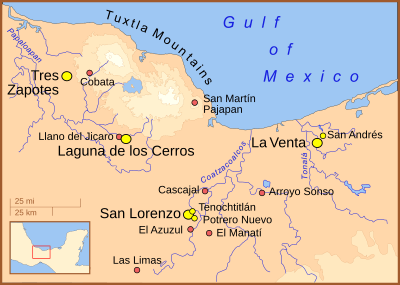San Martín Pajapan Monument 1 facts for kids
San Martín Pajapan Monument 1 is a huge stone statue made by the ancient Olmec people. It's carved from a type of rock called basalt. This amazing sculpture was found on top of the San Martin Pajapan volcano in the Tuxtla Mountains in Veracruz, a state in Mexico. It's special because of where it was found and what it shows about Olmec beliefs.
What the Statue Shows
This statue was likely carved a very long time ago, even before 1000 BCE (that's over 3,000 years ago!). It stands about 1.4 meters (5.5 feet) tall. The statue shows a young leader or important person crouching down. They are lifting a large ceremonial bar. Their right hand is under one end, and their left hand is over the other.
This pose is very similar to other Olmec statues. It probably shows a ruler or a shaman (a spiritual leader) performing a special ritual. This ritual was about lifting the Mesoamerican world tree or axis mundi. This act was believed to create the center of the world. It also connected the human world with the worlds above and below.
The face of the young leader looks very typical for Olmec art. It doesn't try to show a specific person.
The Headdress and Its Meaning
The young leader wears a huge, box-shaped headdress. The front of it looks like a mask. This mask shows features of the Olmec Werejaguar supernatural being. These features include a split head, almond-shaped eyes, and a downturned mouth. This suggests that the human in the statue had become, or was acting with the power of, this supernatural being.
Feathers flow backward from the sides of the headdress. From the top, plants seem to be growing, perhaps maize (corn). This were-jaguar mask is linked to the Olmec rain god. The images on the statue and its location on a mountaintop show a common belief in Mesoamerica. Many ancient cultures believed that mountaintops were where rain gods lived.
How the Statue Was Found

The sculpture was first noticed by a surveyor named Ismael Loya in 1897. It was found again by Frans Blom and Oliver La Farge during their trip in 1925. The statue was on a flat area between the two highest peaks of the volcano's crater.
Around the statue, people found broken offering pots, jade items, and many other objects. These items dated from ancient times all the way to the 1900s. This shows that the statue had been a sacred object for thousands of years. These offerings and the statue itself made the San Martin Pajapan mountaintop a very holy place.
Even though the statue was mostly well-preserved, its face was badly damaged. This damage might have been done on purpose. In 1897, Loya also broke off part of the arms when he tried to steal it. Luckily, most of the statue, except for the face, has been fixed since then.
In 1929, Marshall Seville, from the Museum of the American Indian in New York, studied the statue. He connected it to other similar artifacts based on their style and what they showed. Since the statue probably hadn't been moved far from where it was made, Seville suggested that this "Olmec" art style started in southern Veracruz.
Today, you can see the monument at the Museo de Antropología de Xalapa in Veracruz.
See also
 In Spanish: Monumento San Martín Pajapan 1 para niños
In Spanish: Monumento San Martín Pajapan 1 para niños

